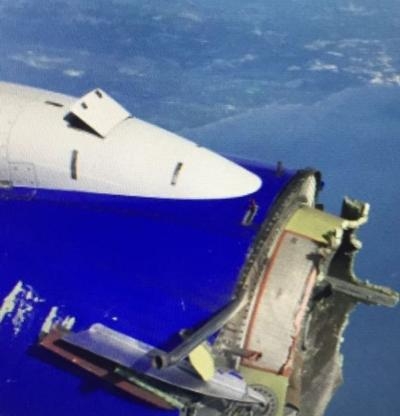Initial Investigation Finds A Hole In The Fuselage Near The Damaged Engine
As part of its ongoing investigation of an Aug. 27, 2016, uncontained engine failure on Southwest Airlines flight 3472, the National Transportation Safety Board issued an investigative update Monday.

The uncontained engine failure happened on a Boeing 737-700 enroute from New Orleans, Louisiana, to Orlando, Florida. The airplane was diverted to Pensacola International Airport, Pensacola, Florida, and safely landed without further incident.
The investigative update details the NTSB’s initial findings from the examination of the airplane and the engine, and a metallurgical examination.
Initial findings from the examination of the airplane include:
- The left engine inlet separated from the engine during the flight. Debris from the engine inlet damaged the airplane fuselage, wing and empennage,
- A 5-inch by 16-inch hole was found in the left fuselage just above the left wing,
- No fan blade or inlet material was found in the hole and the passenger interior compartment was not penetrated, and
- During the accident sequence, the airplane experienced a cabin depressurization.
- The aircraft maintenance records are being reviewed.
Initial findings from the engine examination include:
- One fan blade separated from the fan disk during the accident flight and
- The root of the separated fan blade remained in the fan hub; however, the remainder of the blade was not recovered.
Initial findings from the metallurgical examination conducted in the NTSB Materials Laboratory include:
- The fracture surface of the missing blade showed curving crack arrest lines consistent with fatigue crack growth. The fatigue crack region was 1.14-inches long and 0.217-inch deep,
- The center of the fatigue origin area was about 2.1 inches aft of the forward face of the blade root. No surface or material anomalies were noted during an examination of the fatigue crack origin using scanning electron microscopy and energy-dispersive x-ray spectroscopy, and
- The blades are manufactured of a titanium alloy and the root contact face is coated with a copper-nickel-indium alloy.
NTSB Senior Aviation Investigator Tim LeBaron, the Investigator-in-Charge, is leading a team with expertise in the areas of airworthiness, powerplants, and metallurgy. The flight data recorder and the cockpit voice recorder were shipped to the NTSB Recorder Laboratory and the data from each were downloaded.
Parties to the investigation include the FAA, Southwest Airlines the Southwest Airlines Pilots Association, and CFM International. The French Bureau d’Enquêtes et d’Analyses pour la sécurité de l’aviation civile has appointed an accredited representative who is supported by a technical advisor from Safran Aircraft Engines. CFM International is a joint venture between GE Aviation [US] and Safran Aircraft Engines [France].
Future work will include 3-D measurements of the contact areas of all the blades, a non-destructive examination of the blade surfaces for cracks, and a review of the engine maintenance records.
The accident docket, containing factual group reports and other investigation-related material, will be opened at a future date. Additional information will be released as warranted.
(File image posted to Twitter by SWAPA)
 ANN's Daily Aero-Term (05.10.24): Takeoff Roll
ANN's Daily Aero-Term (05.10.24): Takeoff Roll Aero-News: Quote of the Day (05.10.24)
Aero-News: Quote of the Day (05.10.24) Aero-News: Quote of the Day (05.11.24)
Aero-News: Quote of the Day (05.11.24) ANN's Daily Aero-Term (05.11.24): IDENT Feature
ANN's Daily Aero-Term (05.11.24): IDENT Feature ANN's Daily Aero-Linx (05.11.24)
ANN's Daily Aero-Linx (05.11.24)



